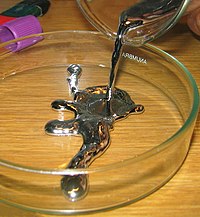
Photo from wikipedia
Background: Fusions (Fs) are major molecular biological abnormalities in acute leukemias (ALs), and all well-known Fs in leukemias are founder variations are routinely used as molecular markers for the diagnosis,… Click to show full abstract
Background: Fusions (Fs) are major molecular biological abnormalities in acute leukemias (ALs), and all well-known Fs in leukemias are founder variations are routinely used as molecular markers for the diagnosis, classification, risk stratification, and targeted therapy but there is a considerable part of ALs that are not screened for other known/unknown transcripts. For example in B-Other B Acute Lymphoblastic Leukemia (B-ALL) [Ph-/-/-; negative for t(9;22); t(1;19); t(4;11); 61% of adult B-ALL], many chimeric genes have been identified leading to a refined classification of B-ALL and to, in some cases, tailored therapies. At this point, a RNA-seq approach is needed but challenging for many aspects, among them a not standardized and very heterogeneous F data analysis. Aims: We developed and validated our integrated pipeline in order to assess targetable biomarkers and to better classify patients (pts). Methods: we performed 1385 gene RNAseq (Illumina) of 224 adult AL samples (112 Ph-/-/-, 41 Ph+, 6 t(1;19), 16 T-LBL/T-ALL and 49 AML). Starting from Ph-/-/-, we developed a combined 4 tool analysis that is further implemented with a filtering strategy with a specific ALs fusion literature filter (Patent PCTEP2021-065692 and 749 ALL Fs database copyright) (Fig.1A). We validate our strategy using: RT-PCR, FISH SNP Arrays; MLPA and total RNA-seq. Results: From 3022 candidate Fs, we retained 160 of them (5.3%; excluding WHO canonical Fs) not otherwise detected, in 120 pts with a high Fs rate in T-LBL/T-ALL, Ph-/-/- and Ph+ (62.5%, 62.2% and 61% respectively) denoting that ALs are not deeply characterized (Fig 1B). The lower rate was found in AML (26.5%), but we were able to identify new ETV6 rearrangement (r) and a FISH cryptic F in a 46, XY pt (TBL1XR1-MECOM). We validated 98 Fs that have been already reported in the literature and 43 novel F transcripts. We obtained a validation rate of 81%. The majority of fused samples (65.2%) had only one detectable F while a smaller group was characterized by multiple Fs. Many of these Fs were previously described in B/T-ALL and AML (e.g. KMT2A-MLLT1, ABL1/2-RCSD1, IGH-MYC, NUP214-SET, ETV6-MECOM). In our bigger sub-cohort (Ph-/-/-), 44 Fs out of 109 (40.3%) were never been reported in Ph- ALL cases. In 15 Ph-like pts, we identified and validate 11 new transcripts. Ph-/-/- F detection help to sub-classify our fused pts in Ph-/-/- subgroups (ZNF384r-11.8%; Ph-like-19.1%; DUX4r- 4.4%; HLFr, MLLr and BCL2/MYC in 2.9%; MEF2Dr-1.5%). Conclusions: we identified pivotal transcripts in all ALs and an unexpected high rate of secondary Fs in adult ALs subgroups (52.4%) that are not characterized with conventional diagnostic methods. The use of an NGS approach and a powerful pipeline permit us to detect Fs useful for a better classification, prognostic identification (e.g. TBL1XR1-MECOM) and in some cases to find targetable Fs (e.g. ABL1-2/RCSD1, NUMA1-CSF1R, ZMYM2-FLT3). Supported by: L3P2505. Citation Format: Anna Ferrari, Silvia Vitali, Eugenio Fonzi, Andrea Ghelli Luserna Di Rora, Chiara Domizio, Cristina Papayannidis, Maria Teresa Bochicchio, Giovanni Marconi, Daniele Dall'Olio, Michela Tebaldi, Michela Rondoni, Barbara Giannini, Fabio Giglio, Crescenza Pasciolla, Monica Fumagalli, Sara Galimberti, Gastone Castellani, Daniel Remondini, Giorgia Simonetti, Giovanni Martinelli. Fusion landscape in acute leukemias: A submerged world of not routinely characterized transcripts [abstract]. In: Proceedings of the American Association for Cancer Research Annual Meeting 2023; Part 1 (Regular and Invited Abstracts); 2023 Apr 14-19; Orlando, FL. Philadelphia (PA): AACR; Cancer Res 2023;83(7_Suppl):Abstract nr 6163.
Journal Title: Cancer Research
Year Published: 2023
Link to full text (if available)
Share on Social Media: Sign Up to like & get
recommendations!